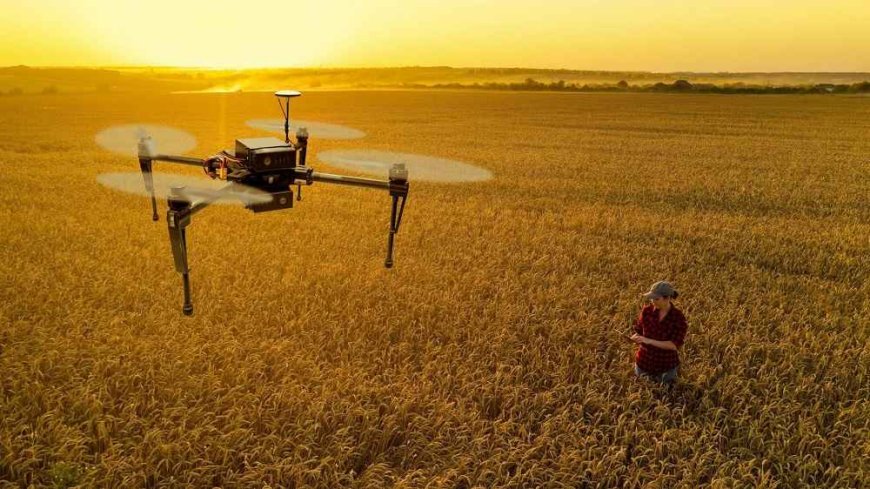Revolutionizing Agriculture: Harnessing the Power of Technology for Sustainable Food Production
In an era marked by rapid technological advancements, the agricultural sector is undergoing a remarkable transformation.

In an era marked by rapid technological advancements, the agricultural sector is undergoing a remarkable transformation. The integration of technology in agriculture is revolutionizing the way we cultivate, manage, and harvest crops. From precision farming to smart irrigation systems, from drones to data analytics, technology is driving sustainable practices, improving productivity, and ensuring food security. In this article, we will explore the diverse applications of technology in agriculture and how they are reshaping the future of farming.
Precision Farming:
Precision farming, also known as precision agriculture, leverages technology to optimize agricultural practices on a site-specific basis. It involves using sensors, GPS, and remote sensing technologies to collect data on soil conditions, crop growth, and environmental factors. This data is then analyzed to make informed decisions regarding irrigation, fertilization, and pest management. By precisely targeting resources and interventions, precision farming reduces waste, minimizes environmental impact, and enhances overall crop yield and quality.
Internet of Things (IoT) and Sensor Technology:
The Internet of Things (IoT) has found its way into agriculture, revolutionizing farming operations. Sensors embedded in soil, machinery, and livestock enable real-time monitoring of vital parameters. Farmers can remotely track soil moisture levels, weather conditions, livestock health, and equipment performance. This data-driven approach empowers farmers to make timely interventions, optimize resource usage, prevent losses, and improve overall farm efficiency.
Drones and Remote Sensing:
Unmanned aerial vehicles, commonly known as drones, are transforming agriculture by providing valuable insights from above. Equipped with high-resolution cameras and multispectral sensors, drones capture detailed images of crops, detecting early signs of stress, nutrient deficiencies, or pest infestations. This data assists farmers in making targeted interventions, optimizing pesticide usage, and improving crop health. Drones also aid in mapping fields, monitoring crop growth, and assessing water distribution in irrigation systems.
Data Analytics and Farm Management Systems:
The collection of vast amounts of data in agriculture has given rise to data analytics and farm management systems. These technologies enable farmers to analyze historical and real-time data to gain valuable insights into crop performance, resource allocation, and profitability. Data-driven decision-making helps farmers optimize crop rotation, implement predictive analytics for disease prevention, and make informed choices regarding market demands and supply chain management.
Smart Irrigation Systems:
Water scarcity and efficient water management have become critical concerns in agriculture. Smart irrigation systems utilize real-time data and sensors to deliver water precisely when and where it is needed. These systems consider factors such as soil moisture levels, weather conditions, and crop water requirements to optimize water usage. By reducing water waste, minimizing energy consumption, and improving crop health, smart irrigation systems play a vital role in sustainable agriculture.
Vertical Farming and Controlled Environment Agriculture (CEA):
With the growing population and limited arable land, vertical farming and controlled environment agriculture (CEA) have emerged as innovative solutions. These methods utilize technology to create optimal growing conditions in vertically stacked layers or controlled environments. LED lighting, hydroponics, and automated climate control systems enable year-round cultivation of crops in urban areas or regions with adverse climatic conditions. Vertical farming and CEA maximize space utilization, conserve water, and reduce the need for pesticides, while providing fresh produce locally.
Robotics and Automation:
The integration of robotics and automation in agriculture is streamlining labor-intensive tasks and optimizing operational efficiency. Robots equipped with advanced sensors and AI algorithms can perform activities such as planting, harvesting, and sorting with precision and speed. Automation reduces labor costs, improves productivity, and minimizes the risk of human error. Additionally, robotic systems can operate around the clock, ensuring timely completion of tasks and enhancing overall farm productivity.
Blockchain and Supply Chain Transparency:
Blockchain technology is finding its application in enhancing transparency and traceability in the agricultural supply chain. By leveraging decentralized ledgers, farmers, distributors, and consumers can track the journey of food products from farm to table. Blockchain ensures that information about origin, quality, and production processes remains secure and accessible. This transparency fosters trust, enables fair pricing, and supports sustainable practices by reducing food fraud and promoting ethical sourcing.
Biotechnology and Genetic Engineering:
Advancements in biotechnology and genetic engineering are revolutionizing crop breeding and enhancing plant characteristics. Genetic modifications can improve crop resistance to pests, diseases, and environmental stresses. Biotechnology also plays a crucial role in developing drought-tolerant varieties, increasing nutrient content, and reducing the need for chemical inputs. These innovations contribute to more resilient and productive crops, ensuring sustainable food production in challenging environments.
Farmer Education and Digital Literacy:
As technology becomes an integral part of agriculture, it is essential to focus on farmer education and digital literacy. Training programs and workshops enable farmers to understand and embrace technological tools effectively. By providing access to digital resources, training on data analysis, and support in adopting new technologies, farmers can maximize the benefits of agricultural innovations. Empowering farmers with digital literacy enhances their decision-making capabilities, productivity, and overall farm management skills.
The utilization of technology in agriculture is transforming the sector into a dynamic, sustainable, and efficient industry. Precision farming, IoT, drones, data analytics, smart irrigation, robotics, blockchain, biotechnology, and digital literacy are driving the revolution in agriculture. By embracing these advancements, farmers can optimize resource usage, improve crop yields, mitigate environmental impact, and contribute to global food security. The collaboration between technology innovators, farmers, policymakers, and researchers is crucial in harnessing the full potential of technology for a resilient and sustainable agricultural future. With continued innovation and adoption of technological solutions, we can ensure that agriculture remains at the forefront of addressing the challenges of our ever-changing world.
